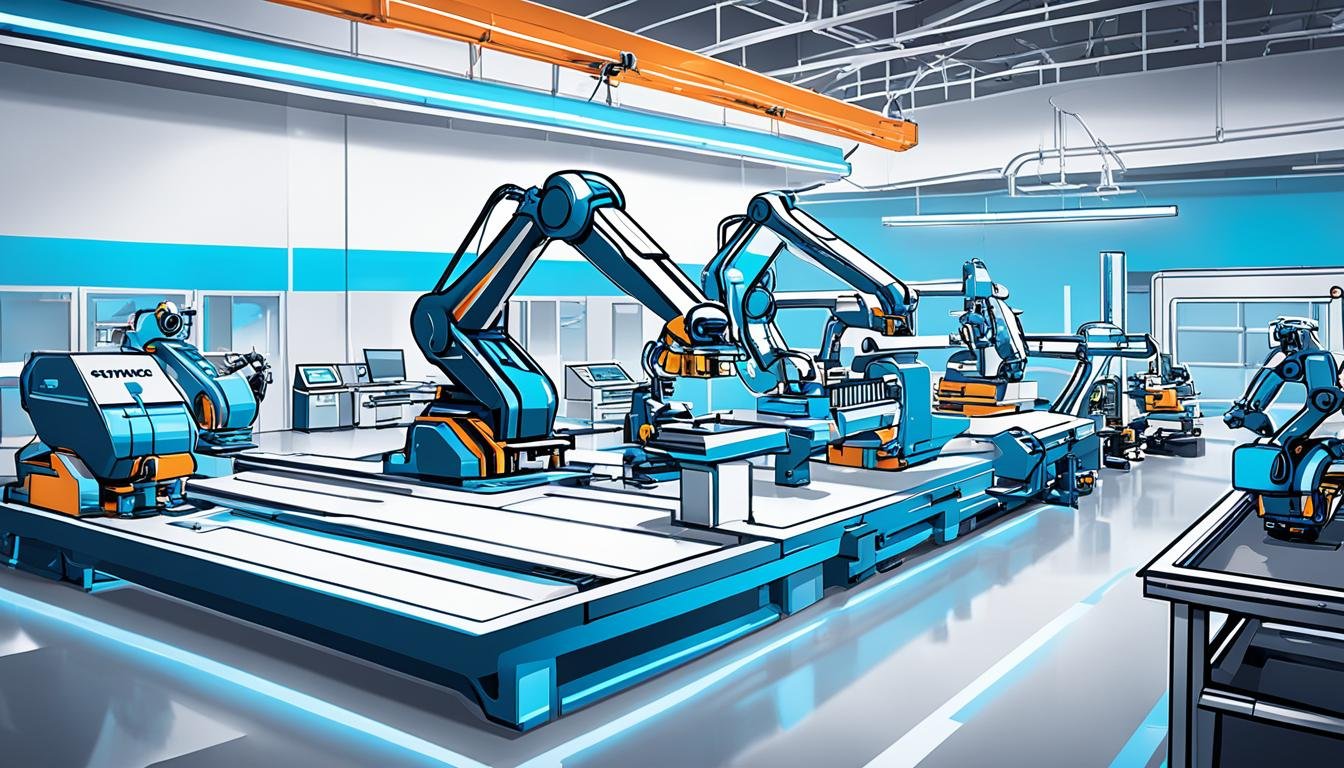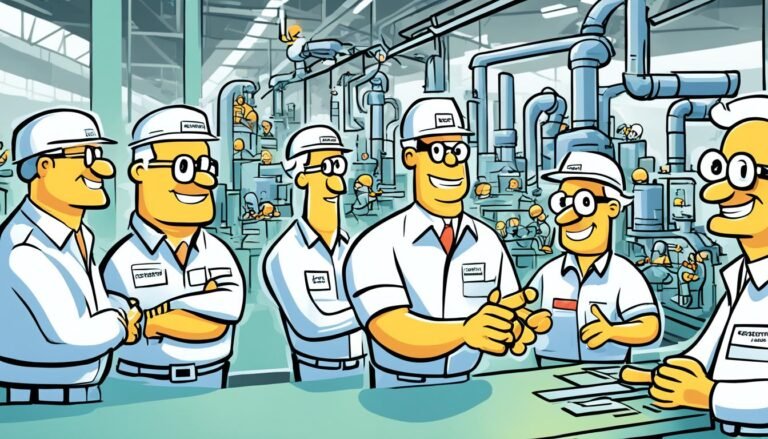Engineering and Manufacturing: Innovate & Create
Did you know the global manufacturing industry is set to hit $44 trillion by 2024? This growth is fueled by constant engineering innovation and advancements in CNC machining. Innovative Manufacturing Engineering (IME) leads this charge, offering custom industrial equipment and components since 2011.
IME uses top-notch CNC machining and milling to focus on quality, consistency, and reliability. They work with materials like steel, aluminum, and brass. This shows their dedication to making products that work well and last long. IME values people and builds strong relationships with clients, blending innovation with precision manufacturing. Their skill in making complex parts helps businesses stay ahead in the competitive market.
Key Takeaways
- The global manufacturing industry is projected to reach $44 trillion by 2024.
- Innovative Manufacturing Engineering (IME) focuses on continuous improvement and customization.
- IME uses state-of-the-art CNC machining and milling technologies for precision components.
- Quality, consistency, and reliability are core values in IME’s manufacturing processes.
- IME’s commitment to long-term client relationships ensures a people-first approach.
- The company’s expertise in industry-specific components offers businesses a competitive advantage.
Introduction to Engineering and Manufacturing
Engineering and manufacturing have changed a lot in recent decades. This change is thanks to the fast pace of technology. Now, modern manufacturing uses many advanced technologies. Each one plays a key role in making the industry better.
The Evolution of Engineering and Manufacturing
The history of engineering and manufacturing is full of big changes. At first, it was all about manual work and simple machines. But then, digital manufacturing came along and changed everything.
This change has made things much better. Old ways of doing things are now replaced with new, smarter methods. These use AI in manufacturing and the Industrial Internet of Things (IIOT).
Blockchain manufacturing makes the supply chain clear and safe. It makes the industry more reliable. Robotics automation also helps by making things more precise and cutting down on mistakes.
The Role of Technology in Modern Manufacturing
Technology is very important in today’s manufacturing. Additive manufacturing, or 3D printing, has changed how we design and make products. It lets us make changes quickly and customize things easily.
AI in manufacturing helps make smart choices, making production better and reducing downtime. IIOT connects machines and systems, allowing for real-time monitoring and data analysis. This leads to better efficiency and predictive maintenance.
Working with robotics automation, IIOT helps create smart factories. In these factories, everything talks to each other, making things run smoothly and efficiently.
“The transformative journey of engineering and manufacturing is propelled by the confluence of cutting-edge technologies and expert industry networks.”
The Impact of Industrial Automation
Industrial automation has changed the way we make things, making things faster and more efficient. It has brought big changes, like better precision in making parts and using CNC Milling solutions. Let’s look at how this change has helped industries grow and innovate.
Benefits of Automation in Manufacturing
Automation in making things has many good points, pushing progress and new ideas. The main benefits are:
- Increased Efficiency: Machines work well all the time, cutting down on breaks and making more stuff.
- Cost Reduction: Using fewer people and resources saves money for companies.
- Improved Quality: Making things with precision means they are better quality.
Companies like IME show how industrial automation can meet high standards and keep production quality steady.
Key Technologies in Industrial Automation
Some key technologies are key to automation’s impact in making things. These include:
- Multiaxis CNC Milling Solutions: These systems make complex parts with great precision.
- Robotics: Robots do repetitive tasks better and faster, making things more productive and cutting down on mistakes.
- Intelligent Software Systems: These use learning machines and AI to make processes better and predict when things need fixing.
Together, these technologies help manufacturers stay ahead, meet new demands, and make quality products.
| Benefit | Description |
|---|---|
| Efficiency | Automation makes things run smoothly and consistently, making more and being reliable. |
| Cost Reduction | It cuts costs by using resources better and needing fewer people. |
| Quality | Makes products better with precise machining, meeting high standards. |
Process Optimization for Enhanced Productivity
Maximizing productivity is key for engineering and manufacturing. Process optimization makes sure operations run smoothly and well. By using smart strategies, manufacturers can boost productivity and lead the industry.
Strategies for Process Optimization
Optimizing processes means using several key strategies. Here are some main ones:
- Lean Manufacturing: Cut waste and make production simpler.
- Continuous Improvement (Kaizen): Make small, ongoing changes for better processes and products.
- Total Quality Management (TQM): Get all employees involved in making things better for quality.
- Six Sigma: Use data to cut down on mistakes and make processes more stable.
Tools and Techniques for Efficient Manufacturing
Having the right tools and techniques is key for efficient manufacturing and boosting productivity. Here are some top techniques:
| Technique | Description | Benefits |
|---|---|---|
| Advanced CNC Lathes | Computer-controlled lathes that perform precise machining tasks. | Make things more accurate, cut down production time, and allow for complex designs. |
| Automation Software | Software that controls and manages automated processes. | Reduces mistakes, keeps things consistent, and increases efficiency. |
| Optimized Machining Processes | Improved and structured ways to machine parts for better output. | Makes things more efficient, reduces wear on machines, and ensures quality production. |
Using these strategies and tools leads to better manufacturing and a big boost in productivity. Companies like International Manufacturing & Engineering (IME) show how ongoing improvement and new tech lead to top-notch manufacturing efficiency.
Product Design and Quality Control
In the world of engineering and manufacturing, combining product design innovation with strict quality control is key. This blend ensures products meet customer needs and follow industry standards.
Innovative Approaches to Product Design
Innovative Manufacturing Engineering (IME) uses advanced CNC technology for custom solutions across different sectors. Product design innovation boosts creativity and focuses on real-world use. This makes sure each product is both useful and new.
- Using the latest tools to spark creativity.
- Keeping a mix of looks and function.
- Following industry rules for reliability and safety.
Ensuring Quality through Rigorous Control Measures
IME’s success comes from its rigorous quality control methods. Quality checks are done at every step of production. This ensures consistency and trustworthiness.
- Checking each step carefully.
- Using top-notch testing tools.
- Training staff to keep up quality standards.
IME’s focus on strict quality control leads to products that stand out for their excellence and reliability. This makes them leaders in manufacturing.
The Role of Supply Chain Management
Supply chain management is key to success in engineering and manufacturing. It makes sure operations run smoothly and efficiently. By improving connections and teamwork in the supply chain, companies can bounce back faster and respond quicker.
Optimizing Supply Chains for Greater Efficiency
Today, making supply chains better is a top goal for manufacturers. They use new tech and data to boost supply chain optimization. This helps with forecasting, managing stock, and planning for demand, cutting down on waste and costs.
Real-time tracking and automation keep materials and products moving without a hitch. This makes the supply chain more efficient.
The Importance of Collaboration in Supply Chain Management
Working together is vital for a smooth supply chain. It builds trust and openness with suppliers and partners. This is key for a strong supply network.
Companies need to build strong bonds to keep quality and reliability high. Working together lets them share important info and resources. This helps solve problems fast and innovate.
For example, IME shows how working with others can lead to growth and new ideas. By sharing knowledge and funding, they can achieve more together.
Lean Manufacturing Principles
Lean manufacturing focuses on making things better by cutting waste and making workflows smoother. It aims for efficient production, trying to get more done with less effort, equipment, and time. Companies like IME show how these ideas lead to better teamwork, more innovation, and a focus on giving great results to clients.
What is Lean Manufacturing?
Lean manufacturing is a way to find and remove waste by always improving. It looks at different kinds of waste like making too much, waiting, moving things, having too much stock, unnecessary motion, overprocessing, and mistakes. The goal is to make production smoother and more efficient.
Implementing Lean Principles in Production
Putting lean principles into action means changing the company culture to value constant improvement, doing things right, and giving employees power. Tools like Value Stream Mapping, 5S, and Kaizen help improve processes and build a culture of progress. Companies like Toyota and GE see better efficiency, happier employees, and happier customers by using lean manufacturing.
Getting lean principles to stick means focusing on teamwork and talking well. Giving employees the power to make changes is key. This leads to better production environments and big benefits for the company.
Innovation in Computer-Aided Design (CAD) and Computer-Aided Manufacturing (CAM)
Computer-aided design (CAD) and computer-aided manufacturing (CAM) have changed the game in precision machining and innovative manufacturing. These tools help manufacturers make complex designs and ensure top-notch quality.
Advancements in CAD Technology
CAD has changed how engineers and designers make products. New software lets them create detailed blueprints and 3D models. This makes the design process more accurate and efficient.
Companies like AutoDesk and Dassault Systèmes offer tools that let professionals innovate like never before. They can make complex designs that were once impossible.
The Impact of CAM on Precision Machining
CAM takes these advanced designs and turns them into real products with perfect accuracy. CAM software automates the making process, cutting down on mistakes and making things more consistent. This tech is key for industries like aerospace and automotive, making sure parts are up to high standards.
| Feature | CAD | CAM |
|---|---|---|
| Primary Function | Design and blueprint creation | Execution of manufacturing processes |
| Key Benefits |
|
|
| Applications | Product design, architectural blueprints | Manufacturing of automotive and aerospace components |
By combining CAD and CAM, companies like IME are leading in innovative manufacturing. They ensure their products are top-quality and set the bar high in their industries.
Conclusion
The journey of engineering and manufacturing shows a clear path towards innovation and excellence. We’ve seen the rise of advanced robotics and lean manufacturing. These changes highlight a sector driven by technology and smart planning.
Companies like Innovative Manufacturing Engineering (IME) lead the way in innovation and excellence. They use the latest in CAD and CAM to improve product design and quality. By forming strong partnerships, they boost their skills, ensuring better supply chain management and efficient production.
The future of manufacturing looks bright. Companies are adopting new tech and bold strategies. This not only meets current needs but also sets the stage for a more efficient and innovative future. Their focus on excellence and constant improvement shows their commitment to leading in innovation, sustainability, and serving clients well.







